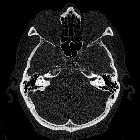labyrinthitis ossificans

Labyrinthitis ossificans, also known as labyrinthine ossification, represents pathological ossification of the membranous labyrinth as a response to an insult to the inner ear.
Clinical presentation
It is usually associated with profound sensorineural hearing loss, and may sometimes be associated with dizziness and/or vertigo. It is the most common cause of acquired sensorineural hearing loss in children.
Pathology
The disorder is most commonly the end result of prior suppurative labyrinthitis, either related to otomastoiditis (tympanogenic etiology) or meningitis (meningogenic etiology) . Other causes include temporal bone surgery or trauma , autoimmune inner ear disease , and sickle cell disease .
Associations
Radiographic features
The scala tympani of the basal turn of the cochlea is the most commonly affected site .
CT
High-density bone deposition within the membranous labyrinth:
- mild disease: hazy increase in density within fluid spaces of the membranous labyrinth
- moderate disease: focal areas of bony encroachment on fluid spaces of the membranous labyrinth
- severe disease: membranous labyrinth completely obliterated by bone replacing fluid spaces
MRI
- loss of normal high signal of fluid within the membranous labyrinth is seen on heavily T2 weighted images (as low signal intensity foci in the labyrinth)
Treatment and prognosis
It may complicate or preclude cochlear implantation.
Differential diagnosis
Possible imaging differential considerations include:
- labyrinthine aplasia or cochlear aplasia
- retrofenestral/cochlear otosclerosis
Siehe auch:
und weiter:

 Assoziationen und Differentialdiagnosen zu ossifizierende Labyrinthitis:
Assoziationen und Differentialdiagnosen zu ossifizierende Labyrinthitis:

